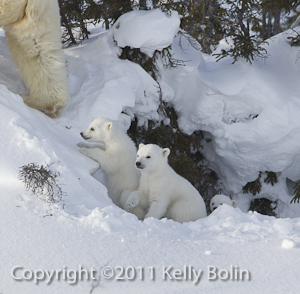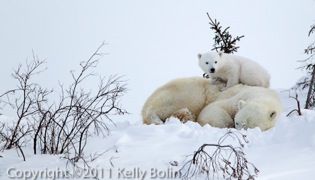
After a week of shooting in Canada’s arctic for baby polar bear cubs in a group of 20, it was an overall great time. Let me go over what worked and didn’t work, but this first part will be a breakdown of the equipment used.
Of course many of you will think “camera gear” for equipment first and foremost but the best camera gear is not going to keep you warm when the temperature hits -40 celsius or colder with the windchill (by the way -40 celsius is the same as -40 fahrenheit = damn cold).
So here is what I wore:
- Canada Goose Snow Mantra Parka (www.canada-goose.com). This is the top of the line parka Canada Goose makes. Trust me you don’t want to skimp on a good winter parka when you are outside shooting all day. This goose down parka never let me down during the entire trip. While bulky, it certainly kept me more than adequately warm and it has more pockets than you can possibly need. Don’t be surprised if you find pockets in this parka after you think you have found them all.
- Canada Goose Rocky Mountain Bibs Overalls (www.canada-goose.com). These pants/overalls are duck down filled pants that comfortably block the cold arctic wind. As with the parka these are “must haves” to keep you warm.
- Boots (www.baffin.com) – there are a wide variety of boots available. I used the Doug Stoup Polar Men boots. While rated at -100c boots they still proved at times not to be warm enough (believe it or not… but that may just be my feet).
- Mid and Base Layers – Key point here is DO NOT WEAR COTTON. Any polyester or wool blend is best. Cotton absorbs your sweat and doesn’t disperse it away from you. When cotton absorbs your sweat it leaves that moisture next to you and then will get cold. In the cold arctic this is a bad idea.
- Socks – Again a good wool sock will do you miles. I wore two pairs of socks, both being either a wool or smart-wool sock.
- Gloves or Mitts – Keeping you hands warm is critical for any photographer, but of course you want to have mobility as well. Using mitts is difficult because you can’t operate your camera very well. Balance this against gloves, they are more agile but not as warm as mitts. The mitts I used are made by Black Diamond (www.blackdiamondequipment.com) called their “Absolute Mitt”. The advantage of this mitt is that it has a separate liner inside that pulls out the thumb and trigger finger separate from your remaining 3 fingers, allowing you access to a firm grip on your camera body and trigger. 🙂
- Inside the mitts would be some light glove liners. These would provide some additional warmth on those very cold days, but generally the Black Diamond mitts kept me amply warm.
- Along with the above, I will say that using “hot hands” (www.heatmax.ca) or (www.heatfactory.ca) for additional warmth in the boots and gloves are a good idea. These products will last anywhere from 5 to 24 hours for additional warmth and comfort.
- Balaclava – Although I didn’t use them often, having a couple available was very handy on those very cold days to keep my face warm. The parka (above) had a hood that when fully extended did keep my face warm on most days; it was those days where we had a head wind that I would use a balaclava.
There are certainly a wide variety of suppliers for extreme winter wear. Others include:
- Cabelas (www.cabelas.com or cabelas.ca)
- Northern Outfitters (www.northernoutitters.com)
- The North Face (www.thenorthface.com)
- Arc’teryx (www.arcteryx.com)
Let me make it perfectly clear, most everyone in our group of 20 had times where they felt cold in this extreme environment; whether it be cold hands or feet. This type of trip requires a lot of preparation to be successful. Although I live in a cold environment already I didn’t underestimate the importance of personal safety.
Next article I’ll talk more about the photography gear and what you need to think about when shooting in extreme winter conditions, but first and foremost you need to take care of yourself.
~ RoTP Team
